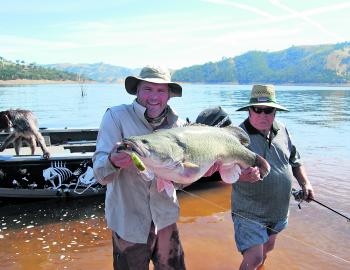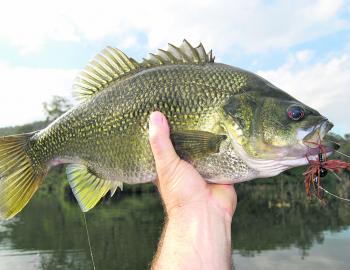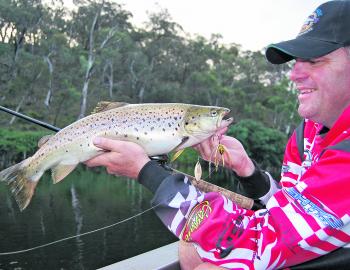It’s hard not to get all caught up in the sights, smells and sounds of summer, cricket on the radio, the rumble and shake of an approaching afternoon storm, the soft straw colours of first morning light in an open field, the smell of wet grass after the storm…
Summer will fade into the colours of Autumn before we know it, but for now let us just soak it up.
Cod know the sights, smells and sounds of summer, too. They might not listen to the cricket, but I am sure they feel and possibly hear the changes that take place before a storm, the changes in air pressure, the rumble in the distance – it’s a definite trigger. I’ve had some great lure casting sessions on cod in the Macquarie and Lachlan rivers as the build up to a storm takes place, especially in a river or creek environment.
This is safe enough as long as you keep in mind lighting strikes and giving yourself plenty of time to make it back to shelter.
Don’t be afraid to go with a surface lure in rivers and creeks, even if it’s still early in the afternoon. Heightened activity with the approaching storm will draw them out of cover, the noise and splash of a surface lure above can be just too much for them. Cod don’t do anything by halves, so once they commit, its game on…
Some recent observations and trolling success in Wyangala has had me thinking a bit. I know it’s a subject and technique that has divisions among the lure fishing fraternity with just as many devotees as detractors. I enjoy catching fish too much to limit my techniques in any way, shape or form, and will quite happily troll when I think it’s the best method of catching fish.
I think it may have been a piece by Warren Steptoe many years ago where he said “drive the lure, not the boat”, and it’s something that has stuck with me whenever I pick up a trolling outfit. To do so most efficiently, you need some tools, eyes underwater, like a quality depth sounder, nothing will help you more when trolling. My eyes are never far from the sounder screen, and I am constantly adjusting the lure to what I am seeing on the sounder via the boat motor. To do this a tiller steer boat wins hands down, and it was one of the main factors in me opting for a tiller steer boat. I can make incremental adjustments quickly via the main motor to suit the bottom topography keeping my lure closer to structure and fish.
A bow mount electric is also very useful when extra stealth is needed, you do lose a little direct control and quick speed adjustment, but when it’s a stealth approach that is needed, it’s the bomb. I also use the transducer on the bow mount electric, even if I am not using the motor itself to move and change direction. Both my transducers are networked so it allows me to get information from the bow, and this allows me to react earlier than if just using the transom mounted transducer.
Repeat runs are important. So many times I see boats head off into the wild blue yonder like they are on some sort of track or rail around the dam that has no stations and nowhere to turn around. My troll runs and lengths are directly related to what I am seeing on the sounder, some of my runs may only be 50m long.
I may hit that run 5-6 times before moving on by trying different lures or different speeds, especially if I can see good structure and fish.
Neutral is one of the most underrated gears on your tiller when trolling. Think of it as your rod and reel, imparting action to the lure underwater – the barra guys up north get it big time, it is such a deadly technique.
Junkyard bass are mean nasty critters that live in the drowned timber of our lakes, and I am sure some of them have collections of expensive Japanese lures stacked on the branches and limbs that surround them. On the big ones my percentage rate would be way less than 50%, and the ones I land are the silly ones.
I do like a fishy challenge though, and have made some adjustments. Going back to a mono leader is one, my thinking has been with a fluro carbon leader, braid, a fast action high modules graphite rod and a tight drag there is very little shock absorption in the system. The other is a change of stance or rod angle, as a few times I was busted off on the strike (the fish strike not mine). Thinking about it made sense, everything was locked up and pointed directly at the fish and the rod played no part in the action.
So now I make a point of having my rod at right angles to the retrieve so that at least it can bend and give a little on the fish’s strike.
I think a lot more about where and how far I cast as well. I think a lot more about which direction my electric motor is pointed before I cast, and wherever possible I try to fish in pairs. It may sound a little extreme, but these fish are brutal, and it can sometimes be quiet an expensive afternoon of leisure.
Hope to see you on the water soon, until then, tight lines!
Reads: 1540
There is a lot more to trolling than meets the eye.

This junkyard bass was one of the silly ones. With a landing percentage rate of less than 50%, I had had to do some serious thinking; it was getting embarrassing and expensive…

Brown trout on spinnerbaits is not the norm, but mixed species dams can throw you curve balls every now and then. The flash and bling of this OSP High Pitcher spinnerbait was just too much for this chunky trout to resist.




